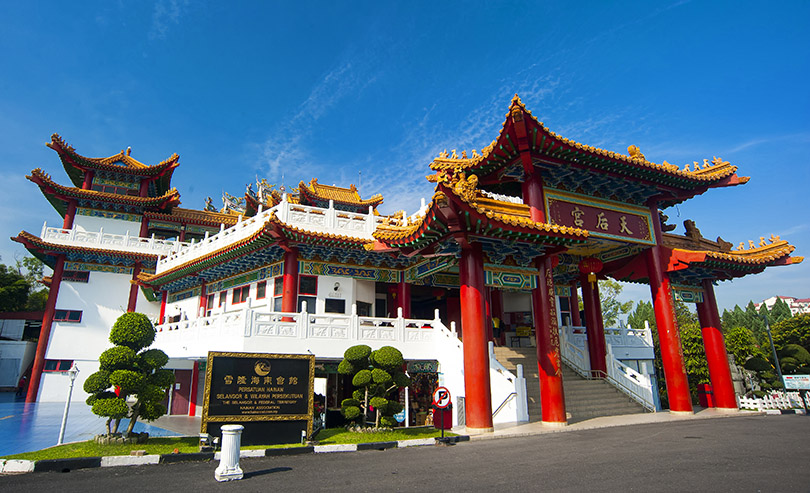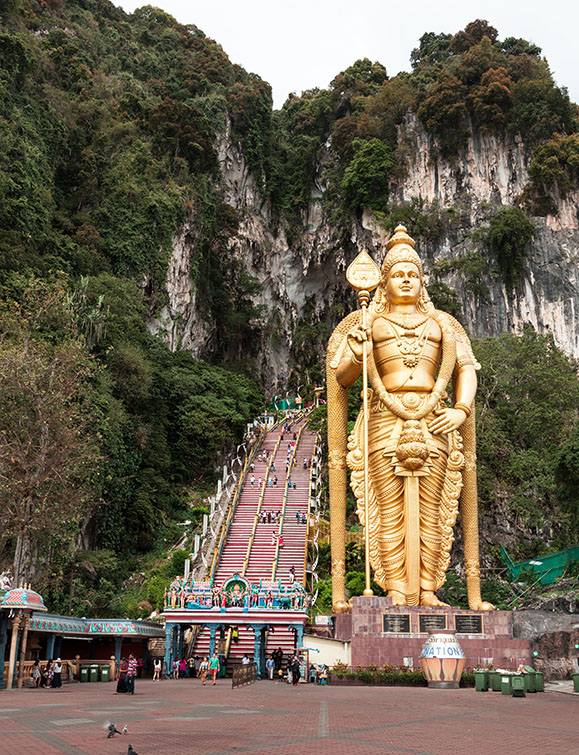
This Chinetemple has golden roofed pagodas and strings of lanterns. Located inside are three majestic statues of deities, including the main deity Thean Hou. Within its grounds are statues of the 12 animals of the Chinese zodiac; credit Malaysia Tourism
Kuala Lumpur Contrast & Diversity
Kuala Lumpur, Malaysia’s largest city, is a melting pot of diverse and contrasting cultures. The government promotes the city’s contrast and diversity as the hook to explore a multitude of attractions. They’ve made a real effort to sustain a tranquil vibe in the mix. Consequently, it thrives as a representation of what is possible in a multicultural society. America could learn lessons here.
The mix of Malay, Chinese, and South Indian peoples competes with the mix of Muslim, Buddhist, Christian, and Hindu religions for greater expression in the city. You will hear the Muslim call to prayer every day as you appreciate the particulars of a Buddhist or Hindu temple.
Kuala Lumpur lives up to its nickname as the magical capital of Malaysia. Locals call it “KL.” Chinese and Indian Immigrant cultures effortlessly fuse with native Malay culture. It’s a place where many races and ethnicities seem to get along. That’s a little surprising compared to other big cities in Asia with diverse populations.
Ethnic diversity can be seen in customs and religious beliefs, as well as languages, cuisines, and architecture. Known as KL to the locals, the city is a heady mix of history and culture intertwined with mushrooming skyscrapers and office towers. Buzzing with life from morning to night, exploring the diverse shopping the vibrant nightlife to its historical heritage – Kuala Lumpur has something for everyone.
Kuala Lumpur is a great example of a city that has managed to preserve the best of its cultural heritage and combine it with modern conveniences to offer a wholly unique experience to visitors. And yet KL maintains a human scale for walking to eye-catching temple & cave visits, bargaining with street vendors, and sampling street great cuisine on the cheap. Bukit Bingtang is the central place for small shops and dining at family-owned restaurants. It’s a dynamic place to meet to eat and commune endlessly it seems.
From the aromas of deep-fried samosas in the food courts to the splendor of mosques that dot the landscape, Kuala Lumpur delivers rich culture on an “I’m broke, but I love to travel” budget. This energetic city, which also features Jazz clubs, easily merits inclusion on the bucket lists of more African-American travelers.

Hindu goddess at Batu Caves entrance; credit Yaopey Yong
Another blessing of this contrast and diversity is the bounty of many cuisines. Hawker centers can be found in almost every corner of the city, serving every type of food in Malaysia. Most, if not all, seem to be open 24 hours. The jumble of residents and ex-pats blends nicely, particularly among the nightlife. The dizzying array of restaurants, bistros, and cafes has something for every taste bud. Kuala Lumpur is fast becoming a culinary capital.
Another surprising diversity is that KL has become a playpen for architects who design eye-catching skyscrapers, including the tallest twin towers (Petronas) and the current 2nd tallest building in the world. Looking at the quality and quantity of its architecture, KL could give Chicago and Toronto serious design competition.
With so many pluses to explore, you will quickly feel why Global Destination City surveys rank Kuala Lumpur Contrast & Diversity close behind Singapore and Bangkok as a must-see urban destination.
